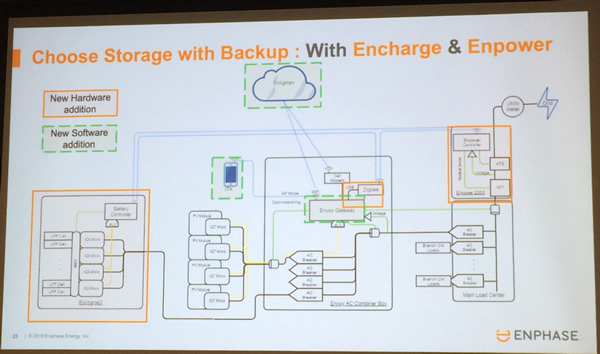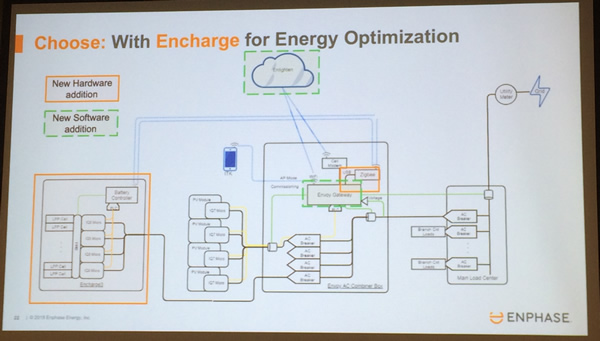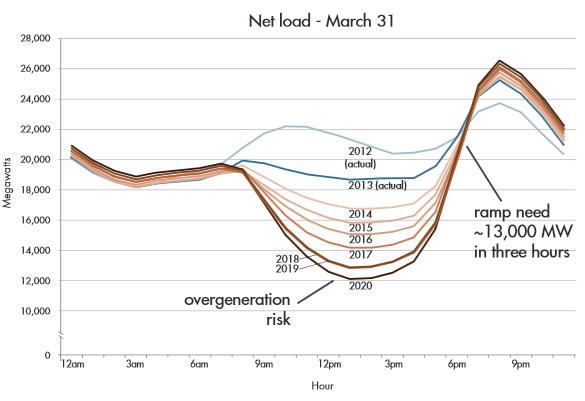Category: "Energy Storage"
04/03/19
Categories: All About Solar Power, Residential Solar, Ranting, Energy Storage
Enphase IQ8 Update... UPDATED
UPDATE - We got a message back from Enphase about a viable approach to the whole-house connection issue discussed below.
The end of March found me in San Diego attending the annual NABCEP Continuing Education Conference. As part of being NABCEP certified, I am required to recertify every three years, and my third recertification occurs this year. The Conference is a convenient way to earn the credit hours needed as part of the recertification process.
While much of that is bone dry (such as a full day talking about the most recent changes to the National Electrical Code, made tolerable only by the wit of the presenter, Ryan Mayfield), or surprisingly cool (such as our discovery of Scanifly), nothing was more anticipated than our chance to attend a talk presented by Enphase titled, “Design and Specification of Grid-Agnostic Enphase Ensemble™ based Systems." (Enphase describes the Ensemble system as being “grid-agnostic” because it is intended to switch seamlessly between grid connected and grid isolated operation.) Here is our take…
The room for this talk, as was the case with a number of talks, was way too small for the number of interested participants. I arrived early and was rewarded with a seat. Late arrivals were SRO. The talk was presented by Peter Lum, with an assist from Field Applications Engineer, Nathan Charles.
Key Takeaways
For folks looking for just the highlights, here are some (in no particular order):
- Initial rollout of the IQ8 in the U.S. will be as part of the Encharge energy storage system
- Encharge will come in two basic flavors, a 3.3 kWh, 1.28 kW unit, and a 10 kWh, 3.8 kW - both with a peak surge output of 150% rated power for one second
- The 3.3 kWh unit will be 24″ high, 13″ wide, and 12″ deep, weighing 88 lbs, mountable either on the floor or the wall, and it can be mounted outdoors
- Cells are LFP, cooling is passive, and comms are - surprise - Zigbee
- The 3.3 kWh unit has four IQ8 microinverters inside, that are field replaceable should one fail
- The battery cells are not tied to any one microinverter; if a microinverter fails the storage capacity is unaffected, but peak output power is diminished
- Warranty will be for 4,000 cycles (100% DoD) or 10 years, whichever comes first
- For a microgrid to form, there must be roughly the same amount of IQ8 power as there is IQ6 or IQ7 power in the system
- Not compatible with M-series microinverters, “at launch”
- No word yet on pricing, anticipated deliveries to begin Q4
A Little More Depth
So those are some highlights, let’s talk about some details. The smarts inside the IQ8 is an Application Specific Integrated Circuit (ASIC) with some 5 million gates. As a result, the IQ8 is able to update its control vectors every 20 ns. Thus, the individual IQ8 provides the primary control over the microgrid, and there is no master/slave relationship. However, the IQ6 and IQ7 do not have that level of independent control functionality, and so they rely on secondary control, via the Envoy, to stay in sync with the microgrid.
As with its other IQ cousins, the IQ8 is a bi-directional inverter, meaning the same device that can be in an array, converting DC to AC, can be in the battery, converting AC to DC to charge the cells.
Keying off the 2017 NEC (which California will adopt come January), we were introduced to a new acronym: MID - which stands for Microgrid Interconnect Device, and is defined as, “A device that allows a microgrid system to separate from and reconnect to a primary power source.” (705.2) The Enphase MID is referred to as Enpower, and it essentially has three components: an automatic transfer switch, a neutral forming transformer (recall that the IQ series just uses the two hots, L1 and L2, so the NFT is necessary to power 120 volt loads when off grid), and a control device. Comms are - you guessed it - Zigbee.
Use Cases
There are two primary use cases for the new Encharge component, Energy Optimization, and Storage with Backup. Let’s look at each one in turn.
Energy Optimization
Energy optimization, or more to the point, Time-of-Use arbitrage, involves storing energy during the peak production portion of the day (instead of exporting it to the grid) and using it later in the day for local consumption. This becomes important as utilities - think SCE - switch to TOU rates where energy in the middle of the day is significantly cheaper than energy during the peak TOU period (more and more, something like 4-9 p.m.).
Our friends over at Energy Toolbase just blogged about, “A Historic Moment for Residential Energy Storage Economics: California’s new Time-of-Use Rates,” noting that for the first time it was possible to model a more economically advantageous system adding storage, than just solar alone. Which means that the Energy Optimization use case may pencil out on its own - though that is hard to say for sure until we have some actual pricing!
Enphase provided the following illustration (sorry for the lousy images, taken from the side with my phone!). You can click on the image to see a larger version.
On the far left is the Encharge 3.3 kWh storage system showing the four IQ8’s. To the right is an array built on an equal number of IQ7 microinverters - but note well, this is not a microgrid configuration. Why? Because it doesn’t have a MID, and per the 2017 NEC, you can’t have a grid-agnostic microgrid without a MID.
In the middle is the latest version of the IQ combiner box. (We just installed one of these and frankly, I’m not a big fan. The wiring for consumption CTs requires you to cross reference an unmarked connection block to the lid for the wiring diagram. This is going to be error prone, IMHO. Also the Envoy has been reduced to just a circuit board w/out its own case. Ok, it’s in a NEMA 4 box so the case is probably not needed, but if you are trying to operate it with the deadfront off (say during testing), you need to watch where you put your fingers! A false economy here, I’d say.)
Note the green boxes which denote updated software both in the cloud and in the Envoy. Also, the Envoy picks up a Zigbee device (to communicate with Encharge) to be attached to one of the two USB ports on the Envoy. (As we noted before, Zigbee is built into Encharge, though not called out on this slide.
This is super easy to set up as the Encharge just lands on one of the breakers in the IQ combiner. And while it may - assuming our friends at ET are correct - pencil out, it isn’t what all the buzz has been about, so let’s turn to that use case, shall we?
Storage with Backup
Ever since I made my pilgrimage to Petaluma last summer, the amazing microgrid has been the feature that everyone is eager to see. The good news is, we are closer! The bad news is, this isn’t going to be as easy as we had hoped. So here is the key diagram from last week:
There is really only one change from the prior diagram and that is in the upper right hand corner, where the Enphase MID - dubbed the Enpower 200G, has been added. The switch is rated at 200 A (that is the significance of the 200, G stands for grid), and in theory could be an all home setup. In a grid outage, the Enpower ATF switches and the microgrid forms - automagically. Depending on the actual array and storage configuration deployed, will determine how much of the house loads could actually be powered here.
There is one fly in the ointment in this illustration. In many parts of the country, the utility meter is mounted outdoors and the distribution panel - the Main Load Center in the slide - is located indoors. In such a scenario, the Enpower MID could be wired in between those two components with minimal disruption or cost.
Alas, in California, at least in Southern California, that is not how we do things. 99.9% of the services that I have ever looked at consisted of a combination meter and load center “all-in-one". The rub here is that there is no easy way to physically interconnect the Enpower device between the meter and the load center. When pressed on that issue, Enphase - accurately, if not helpfully - pointed out that we would have the same problem with any such storage solution and the combo meter/load centers. True enough, but we have been talking about this product for a long time now, and you would like to think that they would have a clean solution in mind as to how to make this work by now.
UPDATE: I spoke with Enphase Field Applications Engineer Nick Dadikozian about the following possible solution. Assuming that the utility and the AHJ go along, you could add a separate meter socket and wire the line side to the service, with the load side of the socket connecting to the line side of the Enpower MID, and the load side of the MID to the load side of the meter socket in the combo panel, or if no way to do that, wire to the line side of the combo meter socket and install appropriately rated jumpers in lieu of the relocated meter.
Of course, another approach is to have a critical loads subpanel, with a breaker on the main panel and the Enpower in between. That, I suspect, will be the approach most commonly taken.
So there you have it – all that I could absorb from our relatively short session, and some follow-on conversations with Peter over the next couple of days. (My thanks to him for his patience in dealing with my myriad questions.)
Eager to hear your thoughts on how you will be using this system.
08/17/18
Categories: All About Solar Power, Residential Solar, Energy Storage
What I Saw at Enphase - Mind Blown!
 Last month during Intersolar, I (along with colleagues Sara and Victoria) was lucky enough to get invited to see a microgrid demonstration featuring the Enphase next-gen IQ8 at their headquarters in Petaluma, California. As I had to sign an NDA as the price of admission, I was unable to write about what I had seen until today, when Enphase hosted their annual Analyst’s Day. But I am no longer bound by that agreement, and can now tell you about what I saw.
Last month during Intersolar, I (along with colleagues Sara and Victoria) was lucky enough to get invited to see a microgrid demonstration featuring the Enphase next-gen IQ8 at their headquarters in Petaluma, California. As I had to sign an NDA as the price of admission, I was unable to write about what I had seen until today, when Enphase hosted their annual Analyst’s Day. But I am no longer bound by that agreement, and can now tell you about what I saw.
To say that I was impressed would be a gross understatement - quite simply, it was the most astonishing thing I have ever seen in the solar industry. Settle in and let me tell you what I saw…
What Happens Today
Before I launch into describing the demo, let me remind you of what happens today. All of the systems that we have installed are what is referred to as “grid-tied” which means that if the grid goes down, the PV system that is capable of back-feeding the grid also goes down, and remains down until the grid comes back. (This is to prevent your house from being an island of energy, feeding the grid, and potentially injuring a worker trying to restore grid service. As a result, this feature is known as “anti-islanding” and it is required of all inverter systems that are connected to the grid.)
Normally this is not a problem, but last month, when it got super hot out here (think 115° F hot!), both SCE and LADWP suffered dozens of outages, taking down PV systems across large swathes of LA County, and leaving frustrated PV owners without power, or A/C, just like their PV-less brethren. Not good.
What I Saw in the Lab
Which brings us to what I saw at Enphase last month.
The lab looked like an ordinary industrial space, but with a series of household appliances and tools at one side. There was a simulated array feeding a bank of IQ8 inverters, and a display that showed the output of the array (i.e., PV production), the total consumption from the loads, and any power being exported or imported to support those loads. At the start of the demo the only load was a single red lamp, and the display indicated that it was drawing roughly 90 Watts. The PV array was producing roughly 1.9 kWs, so the excess 1,800 Watts was being exported to the grid. All super normal stuff.
But then things got interesting…
One of the engineers switched off the breaker that connected the PV array to the grid… and nothing happened! Well, actually, a lot happened, but what didn’t happen was that the red light did not go off. It didn’t even flicker to the extent that we could detect it. But then when you looked at the display you noticed something amazing. Not only had the microinverters created a grid on their own in fractions of a second, but they had throttled the output down so that now the production of the PV array exactly matched the load of the red light! And here’s the kicker - there were no batteries attached to this system!!!
But what fun is just having a light on? How about some toast? So they switched on a toaster, and it lit up, and the total load jumped by about 1,000 Watts, making the total load now around 1.1 kW, and the PV array scaled up to meet it! Still no batteries. And how about this - there was no central controller, no master-slave relationship between the microinverters. Rather, this was the “hive mind” at work, as the micros sensed the demand and scaled up or down as necessary to meet that load!
But wait, there’s more!
The next load to be added was a grinder like you might find on your workbench in the garage. All by itself, that device drew roughly 1,200 Watts, bring our total load to roughly 2.3 kW - more than the maximum output of our simulated array. What would happen when that was added to the mix? Surprisingly little. The grinder spun normally, but the red light dimmed slightly. What was going on? The system’s “hive mind” had lowered the voltage slightly (a microgrid equivalent of a brown out) to meet the amperage demand of the new load mix! So slightly slower than normal, cooler than normal, dimmer than normal, but all operating.
Of course, all good things must come to an end. Our already overloaded microgrid faced one more challenge - a vacuum cleaner with a significant in-rush current, far in excess of what the grid could sustain. Indeed, as soon as they switched the vacuum cleaner to “on", everything shut off. Nothing was damaged, the microinverters just shut off to protect themselves.
Turning on the vacuum cleaner served as the “ah-ha” moment for the potential homeowner - I guess I can’t run everything in grid outage mode. So what do you do when something you just did produced an undesired result? Well if you can, you undo it! Turning the vacuum cleaner off, immediately restored the microgrid to its previous state of operation! No delay. No human intervention - just turn off that latest (over)load, and the system recovers on its own!
How cool is that? Pretty damn cool, if you ask me!
Batteries Please?
So what about batteries, how do they play with this new system? Just exactly as you would want.
The engineers added a bank of batteries to the mix, each with an IQ8 installed. Now the display also indicated the battery’s overall state of charge, and whether they were charging or discharging. Reset the demo to just the red light as a load and the batteries at 30% state of charge. The PV array output jumped back to its maximum, with the surplus energy being used to charge the batteries. As more loads were added, the PV array remained at maximum output, and as needed, drew power from the batteries. Should the batteries reach full capacity and the PV output is greater than the loads, the microinverters will once again throttle down.
Sweet!
What’s Next?
I hope you agree that this was an amazing demo, and the IQ8 (or Ensemble, as Enphase refers to the overall system) has tremendous potential, both for Enphase as a company, and for so many nascent markets. Think of how this product could have helped out in Puerto Rico, or in parts of Africa which have never, ever seen a grid! Makes me want to book a trip to bring power to a village somewhere - hey Laurel, what do you say?
For our own clients, this has the potential to be the answer we have been seeking ever since Elon’s whoppers got people thinking about storage for the first time ever.
A point we raised with Enphase management is the need to have a reasonable upgrade path for existing clients. Indeed, I have a call with Enphase tomorrow to discuss that very topic. We know that current Enphase IQ products (the 6+ and 7+ we have been installing this year) will be compatible with Ensemble. We expect to be able to work with older systems, though there may be a higher retrofit cost. When we have that information, we will surely let you know! The IQ8 is expected to be available in 1H2019… watch this space!
07/23/14
Categories: All About Solar Power, Utilities, Energy Efficiency, Ranting, Energy Storage
Teaching the Duck to Fly
There is a fair amount of talk lately (in nerd circles) about a graph being circulated by the utilities and the California Independent System Operator ( CALISO, the entity that manages the electric grid in the state). Known as the “Duck graph,” it is being presented as a dire prediction of impending grid instability due to the increasing role of renewable energy sources. But where some see doom and gloom, others see opportunity. Here’s our take. (H/T John Farrell at REWorld.)
Here’s the graph (credit, CALISO):
As recently as 2012, this wasn’t a duck at all as net load had two peaks, one in the morning and one late in the evening.
But look at the center of the graph: as more and more renewable sources come online, the demand during the middle of the day falls dramatically, so much so that the utilities are complaining that there will be a risk of “over generation” - producing more energy than is needed and cutting into the baseline production (from power plants like coal and nuclear that need to operate continuously to be efficient.)
Also predicted is a rather steep increase in evening demand between now and 2020.
The net result is a curve shaped much like a duck, apparently a fowl predictor of grid chaos.
Frankly, we look at that graph and see progress and opportunity. Progress in that renewables, which not so long ago were sneered at as being a, “tiny amount of energy that will never amount to anything serious,” are now completely rewriting the load curve in the nation’s most populous state. Talk about coming a long way, baby!
The opportunity, of course, is right there as well. While adding large amounts of smart storage to the grid is an obvious fix for this “problem", as we noted just the other day (see Can Renewables Power the US?), we can handle this evolving energy future in a relatively simple manner—it just requires changing how we approach the problem. Here’s the video:
We can, and will, teach this Duck to fly.





